Connecting with your customers means communicating with them on the channels they most prefer. Here’s an interesting stat: 35% of consumers are open to receiving promotional messages on mobile channels. If anything, that’s like a green light nudging companies to consider using SMS for business communication.
Many companies are already doing this, especially during peak sales periods like Black Friday. But there are many other opportunities to engage your customers throughout the year with SMS, beyond the usual hype times.
Let’s go through some ways to harness the power of SMS for year-round business communication.
What is SMS in business communication?
SMS for business communication refers to the use of text messaging as a tool for companies to interact with customers, deliver important information, promote products or services, and enhance their overall communication strategies.
When businesses use SMS for communication, messages get delivered by a software application rather than from another individual person. This method, known as application-to-person (A2P) SMS, opens a world of possibilities for businesses.
Take a hotel, for instance. They could send a customer a quick text to confirm their reservation, in turn boosting that customer’s satisfaction. Or, a medical provider could send an SMS after an appointment that relays important information to the patient. And while just one person is receiving these messages, the messages aren’t from another person.
But bulk texts count, too.
A retailer could use SMS to message many subscribers with a promotion about a new product, or offering a limited time coupon.
It’s also worth noting that businesses can send more than just text in their business communication. With Multimedia Message Service (MMS) messaging, they can also send audio files, graphics, images, videos, and other forms of multimedia.
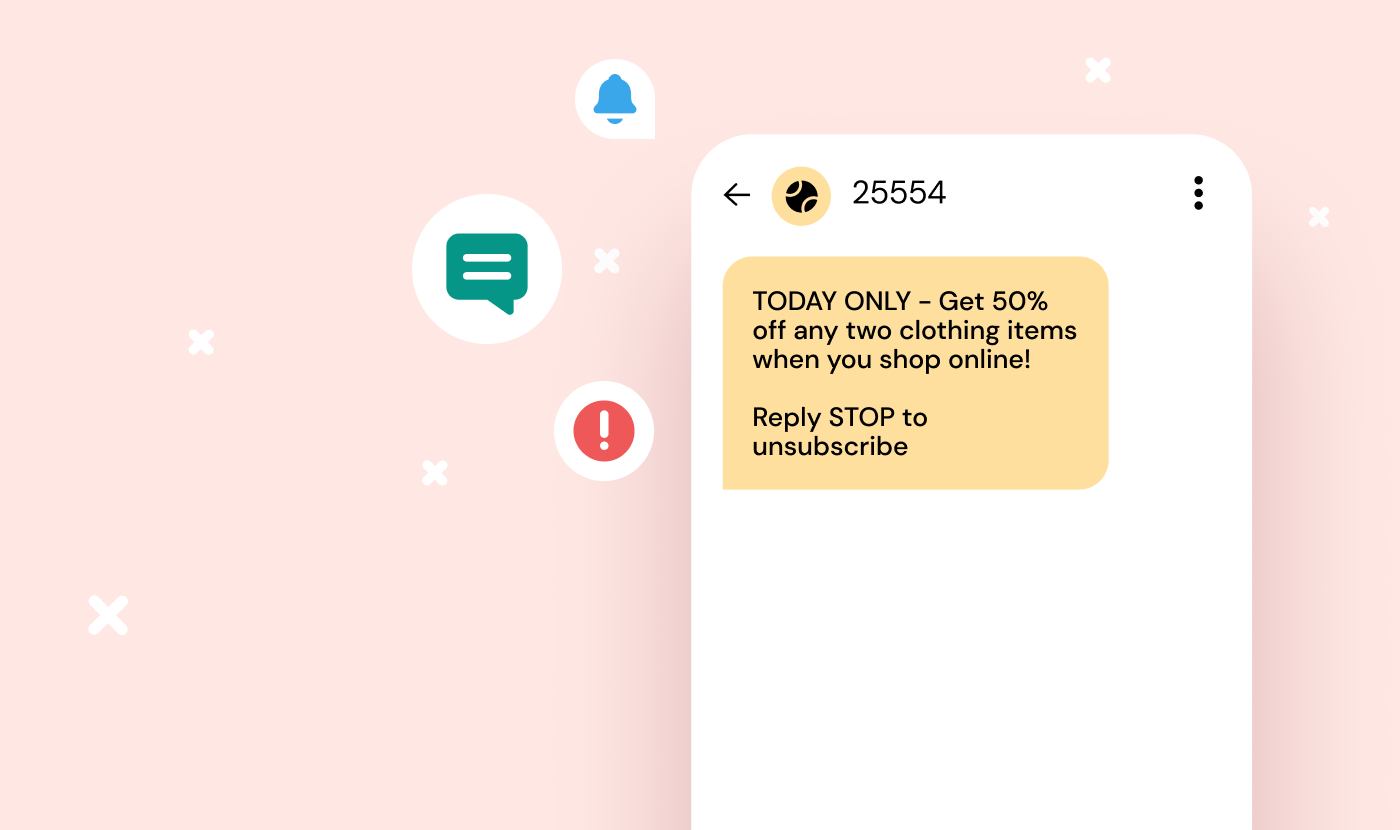
An example of a promotional SMS message for business communication, which in this case features a discount with a same-day deadline.
What are business text messaging benefits?
As we mentioned, there's a sizable slice of your target audience and customer base that will prefer SMS communication. They want to get texts from your company. And beyond just keeping your customers happy, here are four additional benefits of using SMS business messaging:
1. Messages get read instantly
SMS has a really high open rate and, even better, messages get read by most people fairly quickly. In fact, over 80% of consumers look at their text notifications within five minutes of receiving one, and 47% of Gen Z consumers check their texts every 10-30 minutes.
When you send business SMS, you can have a high degree of confidence that a large percentage of your subscribers will not only see the message, but they’ll see it very soon after you’ve sent it. That’s why the one-day flash sale strategy shines with SMS – it can get your message to your intended audience far more quickly than either social media or email.
2. SMS has a wide reach
In the most simple terms, every single person on the planet with a mobile phone can receive text messages. Think about it: We’re talking about a staggering 7.3 billion people worldwide who can be reached through business SMS text messaging. The reach of SMS is beyond compare!
3. Text messages don’t require an internet connection
Every mobile device with a network connection supports SMS. That’s because text messages travel on mobile network technology, so they don’t require a data plan to be sent or received.
Now, sure. Smartphones might proliferate, but there are still people who use or prefer flip phones and less consuming technology. But regardless of your audience’s mobile phone type, they’ll be able to receive SMS – so you’ll be casting a net over a much larger audience with SMS than you would with internet-dependent methods.
4. Messages can be automated
Automation is a lifesaver when it comes to handling routine tasks, and it’s something customers can appreciate too. Think about it – routine communications like order confirmations, shipping notices, and password verifications can be automated through SMS. Once you have systems like this set up and running, employees can breathe easier knowing they don’t have to handle these customer service tasks manually.
And here’s a bonus: You can streamline your automated texts even more using this collection of SMS templates. Templates and automation are simple ways to make things run smoother for everyone involved!
Ways to use SMS business messaging
You’ve seen a few examples already, but there are many other ways to use SMS in business communication. If you’re ready to engage more customers and prospects with the text messaging they prefer to receive from your company, here are seven ways to get started.
1. Marketing campaigns
With SMS, you’re limited to about 160 characters. For the most part, both small businesses and enterprises use SMS marketing in two different ways:
-
One-off messages with clear, direct calls to action.
-
A series of texts that give targeted offers or information to specific segments of a subscriber base, usually over a few days or weeks.
Whichever approach you use, the key is to make it easy to respond. Usually, this means including a link to a landing page. That page could be a dedicated page for this specific campaign, which allows you to easily track the response rate. Or it could be an existing page like a product or category page.
Your CTA might also take the form of a coupon code. This makes it easy for tracking purposes or to make it easier for customers to take advantage of the sale.
Good SMS marketing campaigns do things like:
-
Announce flash sales
-
Introduce new products
-
Re-introduce older products you want to revive, or that have been updated or enhanced
-
Run limited-time offers
-
Give special offers to VIP loyalty members
-
Give targeted offers to segments of subscribers
-
Promote valuable content – with links to pages with more information about a relevant topic
2. Verification
SMS verification refers to the process of confirming a user’s identity or actions by sending a one-time password or code to their mobile device via text message. The recipient then uses that code to log into a website or application.
This method, commonly known as two-factor authentication (TFA), helps businesses keep scammers and cybercriminals from messing with accounts.
This added layer of security is an increasingly common use case of SMS for business communications, because it gives customers more assurance that their information is protected.
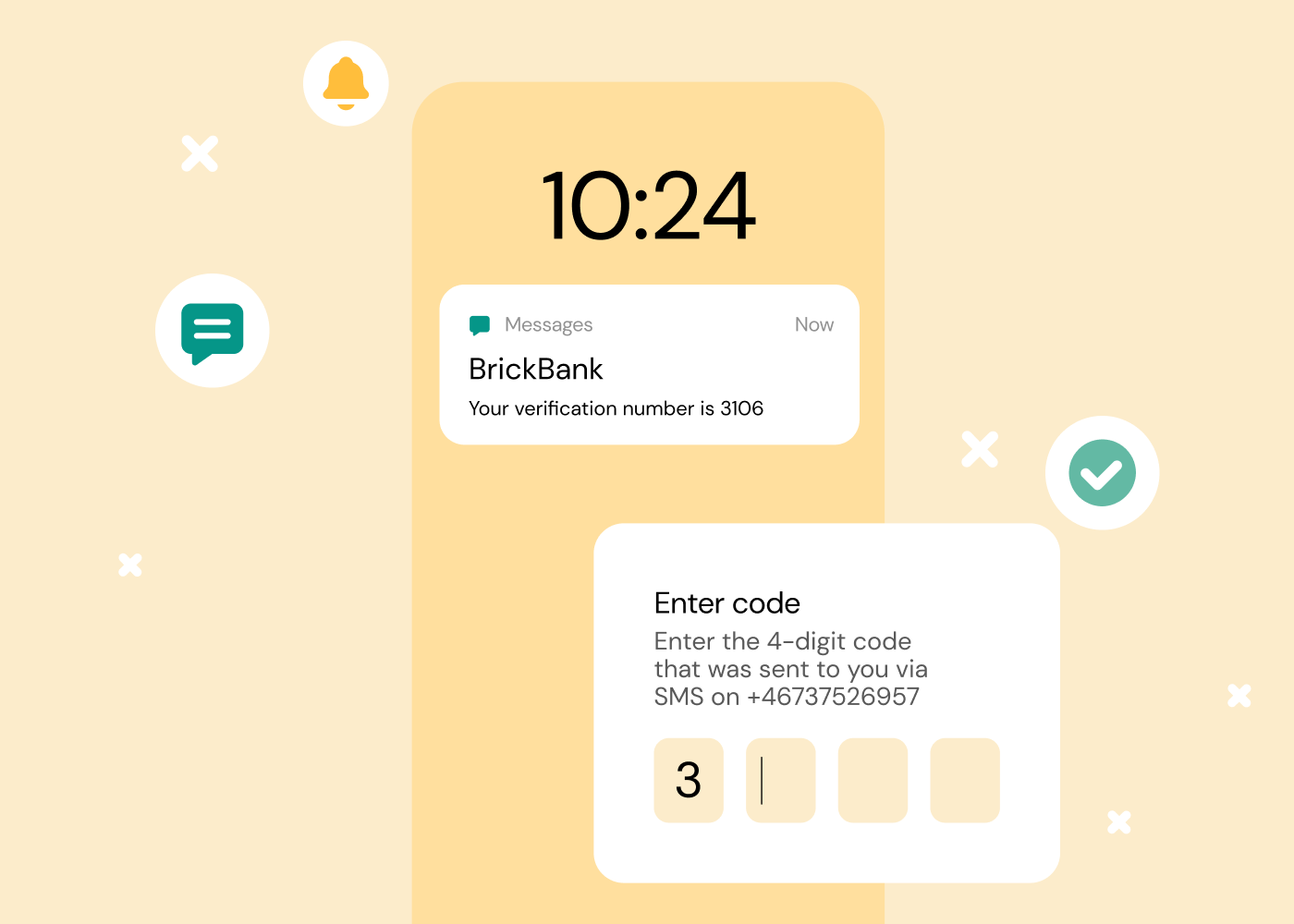
A good example of an SMS verification text, which sends a code to the recipient that they must enter into the website to complete the login process.
3. Customer engagement
Personalized business text messaging helps you connect better with your customers, leading to higher engagement and better response rates. The more you know about your SMS subscribers, the more personalized your communications can be.
You can use SMS to send personalized messages like birthday texts or special offers based on their past purchases. For example, maybe you want to send a special discount to people in a particular city. This shows you understand their needs and appreciate their businesses. And adding personalized. Touches like their name or other information can make the messages even more special.
This personalized approach also works wonders for marketing. You can send out highly effective texts, like limited-time birthday offers, to grab your customers’ attention and keep them engaged with your brand.
4. Opt-in campaigns
Companies of any size can use SMS for lead generation or nurturing through opt-in campaigns. When you invite prospects to opt in for SMS communications, you’re giving them to engage with your brand on their terms, ensuring they’re generally interested in what you have to offer.
Then, you can nurture them with a steady stream of helpful, informative, valuable, and unique content, leading to higher-quality leads.
Any industry can do this – let's take retail, for example.
You can begin by giving a recipient an enticing offer to join your SMS list, whether it’s through an in-store brochure or banner, or an offer in an email. Offering an incentive upon opting in motivates people to get involved and sets the stage for ongoing interaction.
With opt-in campaigns, you can use single opt-in or double opt-in, which requires the recipient to confirm they want to receive texts from your company. This weeds out bots and unserious leads.
Whichever approach you use, you’ll also want to send an automated welcome message that makes them happy to have joined your text message marketing list. If you promised anything in your opt-in campaign, that reward should probably show up in the welcome text, unless you have a plan to send a dedicated one for that purpose. This thoughtful touch will strengthen your initial connection and pave the way for continued customer satisfaction.
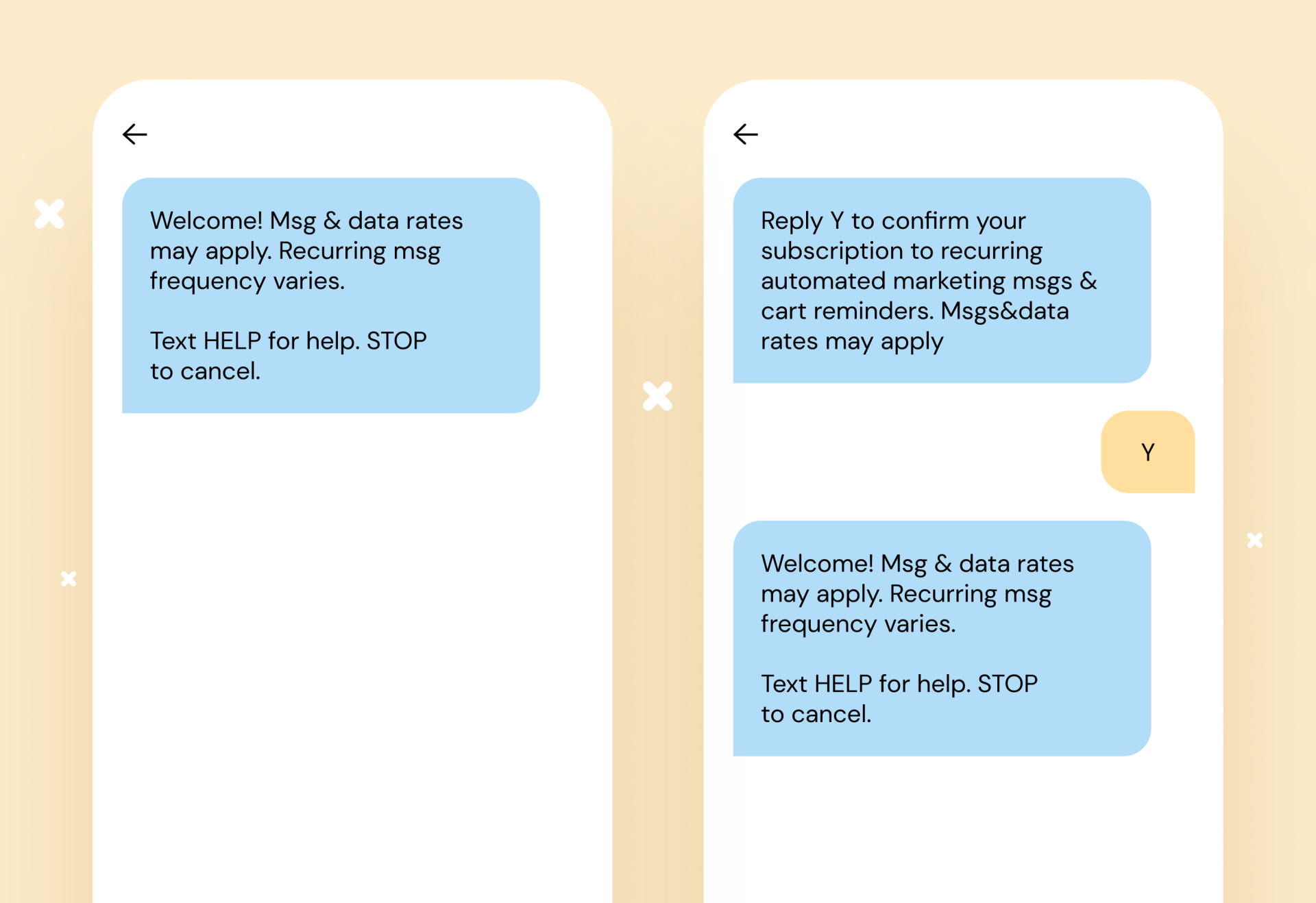
Simple examples of a single opt-in and a double opt-in automated text message.
5. For two-way messaging
Did you know that 90% of customers want to be able to reply in-message to ask questions from companies? Unfortunately, many companies don’t have or use a two-way communication capability – unless they use an SMS API.
With two-way communication, now you’re serving your customers individually and promptly. They feel heard, get questions answered, and appreciate the good customer service. And you’re directly engaging with this person without having to do phone calls or live chat. It’s another way for customers who prefer SMS to interact with your company.
6. Transactional notifications
Transactional notifications are one of the best uses of business text messaging because they're immediate and convenient. When you look at the most common transactions that occur as customers engage with your company, which ones can be supported by automated text messages?
Transactional SMS notifications can include things like:
-
Shipping updates and delivery notifications
-
Purchase confirmations
-
Opt-in confirmations (welcome texts)
-
Password verifications
-
Appointment reminders
-
Payment receipts
-
Notices of changes to previous account or purchase information, like an airline upgrade
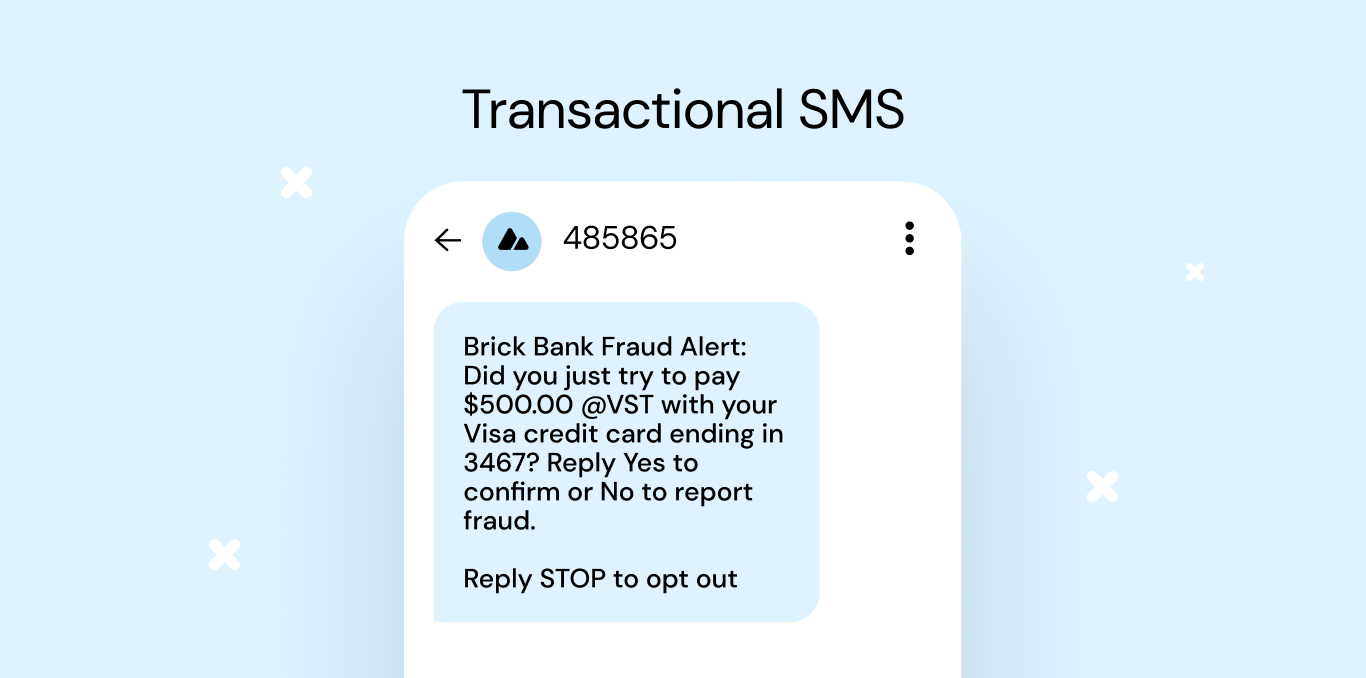
One example of a transactional SMS notification is a bank fraud alert like this one, confirming that the transaction in question is legitimate.
7. As part of an omnichannel strategy
To truly maximize the impact of SMS in your business communications, consider integrating it with other communication channels for even greater effectiveness.
This works especially well with campaigns that last for at least a few days, if not longer. For instance, let’s say you’re running a sales campaign for a particular holiday. You might send out three emails in the week leading up to and including the holiday. Add a text message or two that announce a flash sale, plus a few social media posts giving more details, and you're at the cusp of omnichannel ecommerce.
The goal here is to engage your customers on multiple channels, as each communication channel offers its own unique way of connecting. The more ways you connect, the more effective your communication strategy will be. Email marketing has its own strengths, just as SMS does. Combining them allows you to cover more ground and reach your audience in different ways.
Another innovative approach could be to integrate Rich Communication Services (RCS) alongside SMS. This not only would allow you to include multimedia elements like graphics and videos, but also enables an interactive experience that responds to the recipient’s actions.
What phone numbers can you use for SMS in business communication?
You have four ways to engage with subscribers using SMS for business communications. Each has its advantages. Here’s a quick look at the four types of numbers you can use when asking people to subscribe to your SMS list:
-
Long codes: A long code is a ten-digit number that looks like a person’s normal phone number. If you want to do two-way communication, you’ll need to use long codes.
-
Short codes: Short codes are five or six-digit numbers. These work better if you intend to send a lot of bulk text campaigns because they have a high throughput, so you can send more messages per second.
-
Toll-free numbers: Just like you can use toll-free numbers for voice calls, you can use the same number to send out SMS business messaging as long as it meets the requirements.
-
10DLC: 10DLC is a type of ten-digit long number that supports higher text messaging volumes than standard long numbers. 10DLCs are designated for A2P traffic and are less likely to get rejected by carriers.
Get started with business SMS
As you can see, there are a great number of strategies to use SMS for business communication that will engage and connect with more of your customers in ways they're looking for, and aligning with your specific business needs. It’s a real advantage that can help your company stand out from the crowd.
If you’re ready to get started with SMS business messaging, your first step will be to choose a text message service provider. With so many out there, it’s important to think about eight key things to make sure you're picking the right one:
-
Ease of integration. You want lots of available APIs to make it easy to integrate with your other apps and systems.
-
Security and compliance. Your provider should have backup systems, cyberattack defense and response plans, and who will take some responsibility to keep you safe and compliant with the law.
-
Delivery performance. It’s crucial to find an SMS provider that delivers outstanding performance, with a proven engine that’s optimized for high delivery rates and low latency.
-
Power to scale. Find a provider that can scale up and adapt as needed.
-
Two-way messaging. If the time comes when you want it, you should have a provider who can offer it.
-
Sender ID availability. You want access to this functionality as it Identifies you to the recipient and makes you a more trusted brand and sender.
-
Reporting and analytics. Accessible, robust, real-time metrics allow for the most effective ongoing SMS marketing.
-
Global expertise and customer support. Find a provider who can connect internationally – you may need this now or in the future.
While SMS business messaging is effective, you’ll experience the most success when you make it part of an omnichannel approach to customer engagement.
Omnichannel means more than multichannel. It means things like conversational messaging, and different ways for customers to interact with your company.
Want to know more about conversational messaging? Check out our free ultimate guide to conversational messaging channels.
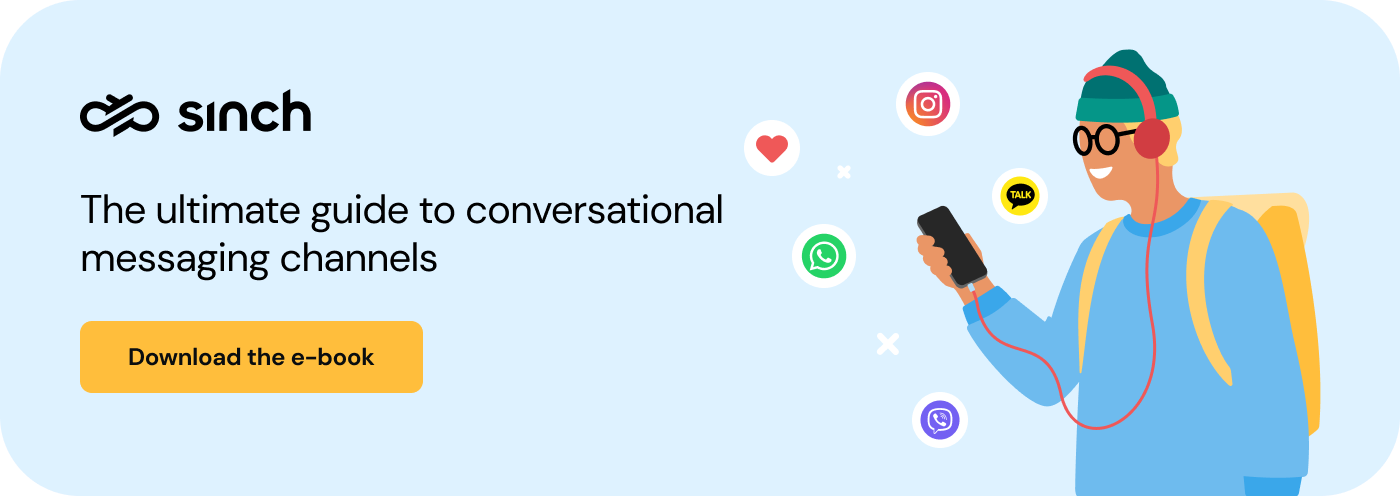
Or, if you’re ready to get started with SMS, let’s chat. Our team is around to help you navigate the process and ensure your SMS campaigns are set up for success!



